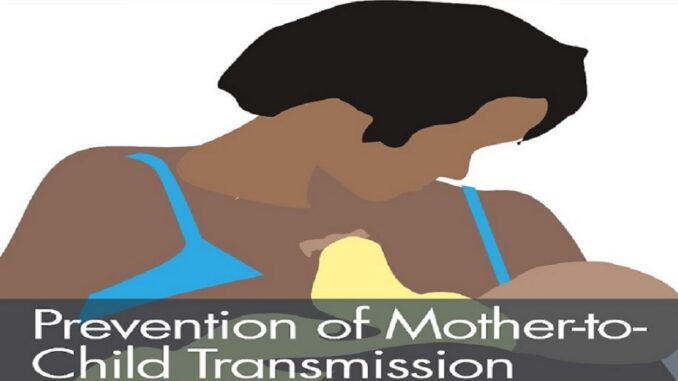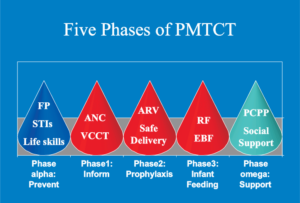
Table of Contents
What is PMTCT?
- PMTCT stands for Prevention of Mother-to-Child Transmission.
- PMTCT is a public health program that aims to reduce the transmission of HIV/AIDS from mother to child.
- It is also known as the prevention of vertical transmission of HIV/AIDS.
- PMTCT is an intervention to prevent the transmission of HIV/AIDS from mother to child during pregnancy, labor, delivery and breastfeeding.
Goals of PMTCT
- Initiate Antiretroviral therapy to HIV positive women
- Provide counseling and support for optimal infant feeding to HIV-positive mothers
- Increase the involvement and support of male partner in PMTCT services
- Improve uptake of infant HIV testing, treatment, and retention
Components of PMTCT
- Prevention, diagnosis, and treatment of HIV for young girls, women living with HIV, and pregnant women
- Early diagnosis of HIV
- Providing technical support, assistance and guidance to the concerned member states/countries
- Promoting and supporting the validation of the Elimination of mother-to-child transmission for HIV (EMTCT)
Strategies of PMTCT
1. Primary prevention of HIV infection
- Preventing HIV infection in parents to be.
- HIV intervention program should target the women and their partners and especially to those at the high prevalence areas
- Special attention strengthening the primary prevention services, such as counseling and testing, promote condom use to reduce the risk of sexual HIV transmission.
2. Preventing unintended pregnancies in women with HIV
- Strengthen family planning services especially among the couples with HIV
- Prevent unintended pregnancies and to avoid having children who are infected with HIV.
- Improve counselling, and testing to promote informed choice decision
3. Preventing vertical transmission or HIV transmission from women to their infants
- The risk of transmission from mother to child decreases through PMTCT
- Those women who are HIV-positive and are pregnant package of PMTCT which includes antiretroviral drug regimens for HIV-infected pregnant women and their newborn, safe obstetric practices and counselling and support for HIV-infected pregnant women on infant feeding options helps in preventing the transmission
4. Providing care, treatment and support for mothers with HIV and their children
- Care and support is integrated along with the treatment
- Offer support for mothers and their infants to ensure the health and overall development
Key Functions of PMTCT
PMTCT program is guided by the WHO global health sector strategy with a target to achieve zero infections among infants. Its key functions include:
- To provide technical support and guidance to member states/countries to develop, strengthen, implement and evaluate policies, strategies and programs for Prevention
- Promote and provide support to the validation of the Elimination of mother-to-child transmission for HIV (EMTCT) and Elimination of congenital syphilis (ECS) in line with the Global guidance on criteria and processes for validation: elimination of mother-to-child transmission of HIV and syphilis
- To improve uptake of antenatal services, HIV & syphilis testing and treatment during pregnancy, safe childbirth practices and appropriate infant feeding as well as uptake of infant HIV testing, treatment and retention
- To proactively collect, analyze and analyze regional trends of MTCT
- To strengthen partnership and PMTCT network with other partners for the exchange of experiences and data in order to promote an integrated approach for PMTCT, EMTCT and ECS.
- To foster integration of activities related to HIV and Syphilis in women and children with Communicable Disease cluster
Why PMTCT?
- There were approximately 36.7 misllion people worldwide living with HIV/AIDS at the end of 2016. Of these, 2.1 million were children (<15 years old).
- 160,000 children (<15 years) were newly affected in the year 2016
- 1 million people died from AIDS-related illnesses in 2016
- The risk of transmission of HIV from mother to child can be lowered to 2% when the mother and child has taken antiretroviral medicines
- In the absence of any intervention, transmission rates range from 15% to 45%.
- Globally, there were still 1.4 [1.1 -1.7] million pregnant women with HIV in 2017 of which an estimated 80% received ARV drugs for preventing mother-to-child transmission (PMTCT) of HIV and still many remains unserved.
- Cuba became the first country to be validated by the World Health Organization (WHO) to have eliminated mother-to-child transmission of HIV and syphilis (2015)
Phases or Stages of PMTCT
There are basically five phases/stages of PMTCT. They are:
- Phase alpha- It includes family planning (FP) services and prevention of Sexually Transmitted Infections (STIs)
- Phase 1: inform- It includes Antenatal Checkup (ANC), Voluntary Confidential Counselling and Testing (VCCT)
- Phase 2: Prophylaxis- It includes the introduction of Anti-retro viral (ARV) and safe delivery
- Phase 3: Infant feeding- It includes replacement feeding (RF) and exclusive breastfeeding (EBF) to the infants.
- Phase Omega: Support- It comprises of providing social support and Pneumoystis jeroveci pneumonia prophylaxis (PCCP)

Effects of PMTCT on Health
- The PMTCT has positive effect of the health of mother and child
- PMTCT has found to be effective eon decreasing the obstetric complication
- Increase in number of Antenatal Care (ANC) due to PMTCT
- The postpartum care provided ensure the safety, good health and overall development of the mother and child
- PMTCT is also necessary to decrease the stigma regarding the HIV and AIDS
- PMTCT promotes the family planning services which is beneficial for the entire family
Guidelines
- WHO released the new guidelines regarding PMTCT in the year 2015.
- All pregnant women living with HIV will be immediately provided with lifelong treatment, regardless of CD4 count.
- This approach is called Option B+
- While previously women living with HIV only take antiretroviral drugs after breast feeding if it benefits her own health
- Option B+ is an improvement on Option B
- Option A totally depended upon the CD4 counts which was not possible in resource constraint setting and this guideline overcomes this drawback
References and For More Information
https://aidsfree.usaid.gov/resources/pkb/biomedical/prevention-mother-child-transmission-hiv-pmtct
https://www.avert.org/professionals/hiv-programming/prevention/prevention-mother-child
https://www.k4health.org/toolkits/pmtct/pmtct-strategies
https://www.red.org/reditorial/2016/03/01/what-is-pmtct
http://www.who.int/hiv/pub/mtct/strategic_vision.pdf
https://www.hiv.gov/hiv-basics/overview/data-and-trends/global-statistics
http://www.who.int/hiv/topics/mtct/en/
http://www.who.int/hiv/mediacentre/news/cuba-mtct/en/
http://www.who.int/hiv/pub/toolkits/PMTCT%20HIV%20Dept%20brief%20Oct%2007.pdf
http://www.who.int/hiv/PMTCT_update.pdf
https://www.unicef.org/aids/files/hiv_Key_considerations_options_B.pdf
http://www.who.int/gho/hiv/epidemic_response/PMTCT_text/en/
https://obgyn.onlinelibrary.wiley.com/doi/pdf/10.1111/j.1471-0528.2010.02692.x